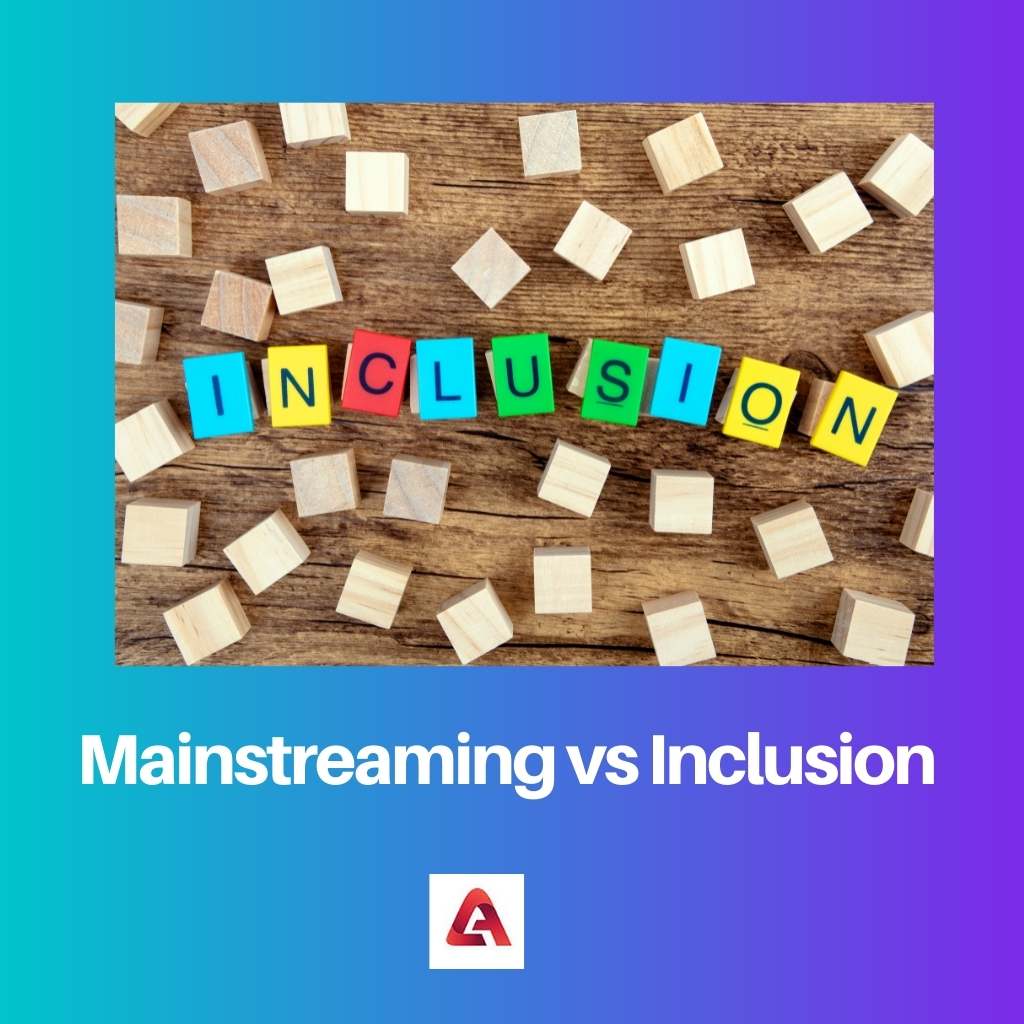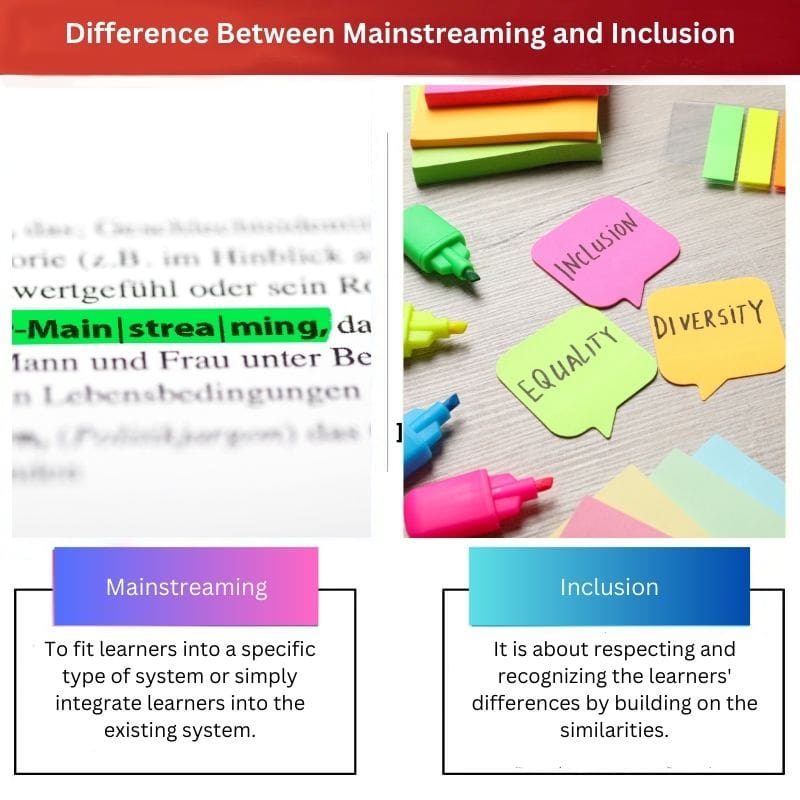Among the academic programs, mainstreaming and inclusion are two of them. They are specially meant for IEP students, in which the Individualized Education Program is the abbreviation for IEP.
It is a legal document describing a specific required education program.
It is specifically designed for unique child needs as well as requirements. These two academic programs are no more just a courtesy provided by the school but become mandatory in school.
To clear up the confusion between mainstreaming and inclusion, this article focuses on differentiating them.
Key Takeaways
- Mainstreaming places students with special needs in general education classrooms for some activities, while inclusion integrates them fully into general classrooms.
- Inclusion emphasizes full participation and equal access to education, whereas mainstreaming focuses on providing support within the general education setting.
- Teachers in inclusive classrooms adapt the curriculum to accommodate diverse learners, while mainstreaming may involve separate instruction in special education classrooms.
Mainstreaming vs Inclusion
Mainstreaming is the practice of placing students with special needs in regular classrooms for part or all of the school day, with accommodations and modifications to support their learning. Inclusion is the practice of integrating students with special needs into the regular classroom setting.

The chief purpose of mainstreaming is to involve students suffering from disabilities within traditional classrooms.
The same opportunities should be given to other students to gain knowledge, access instruction, grow as an individual, and participate in the school’s socializing and academic environments.
Inclusion refers to children’s integration with various needs into mainstream schools. It is much more than the mere children enrolment with special needs and concern for mental health in regular classrooms.
It acknowledges that a child’s academic potential cannot be developed separately from physical, social, and emotional potential.
Comparison Table
| Parameter of Comparison | Mainstreaming | Inclusion |
|---|---|---|
| Interpretation | To fit learners into a specific type of system or simply integrate learners into the existing system. | It is about respecting and recognizing the learners’ differences by building on the similarities. |
| Services | Students travel to get them | Brought to the student |
| Teacher | Special education teacher | General education teacher |
| Introduction of concepts | Ovide Decroly | Maria Montessori |
| Focus | On the learner | On the adaption and support system accessible in a classroom |
What is Mainstreaming?
Mainstreaming is the method in which special education services in a general classroom are given to students while specific periods are the roots of their skills.
Special education classroom students, at certain times, combine the classroom of regular education that is suitable for special education students. The regular classrooms, such as art or physical, might be attended by students.
In a separate classroom, these students sometimes attend science and maths, but a separate classroom to attend English is also there.
School practising mainstreaming believes that special needs students fail the task to a certain extent in a general education classroom due to belonging in the special education environment.
Access to a classroom of special education of known as a resource room or separate classroom, is valuable to disabled students. Students can work one-to-one with teachers of special education and address any need for remediation.
Many educators, parents, and researchers have advocated these classrooms’ importance amongst political environments that want their elimination.
In comparison to exclusion, mainstreaming practices have shown to be more effective academically. Oftentimes, students have certain supports that they bring to the classroom of general education.
The most common support is to bring aid one-on-one to assist them. Some other equipment might be tools from their special education classroom that assist them in keeping up with the demand of the general education classroom.
What is Inclusion?
Inclusion is a version wherein most of the time of special needs students is spent with students who require no special needs. When it comes to special education, the program of individualized education or simply the 504 plan arises with it.
The aim is for special needs students to acquire mixed experiences to become successful.
Special classrooms or schools are used in inclusion to disconnect disabled students from students who are not disabled. These kinds of classrooms fail to accept the concept of a separate classroom.
Most frequently, the school uses it for selected students requiring mild to moderate special needs.
Rarely are there fully inclusive schools that did not separate the programs of general education and special education, instead, it is redesigned to learn together for all the students.
It is regarding the child’s right to participate as well as the duty of the school to accept that child.
There is a premium placed upon students with disabilities for their full participation and regard for civil, educational, and social rights.
The feeling is not limited to disabilities of cognitive as well as physical but also involves the full range of human diversity concerning culture, age, language, and other forms of differences.
Main Differences Between Mainstreaming and Inclusion
- To participate in a classroom of general education, a set of criteria must be met by a student in mainstreaming. Meanwhile, in inclusion, regardless of student ability, it can participate in a classroom of general education.
- Extra support is given to some learners in mainstreaming to fit into the normal classroom. On the flip side, to meet the full range of learning, the support to educators, learners, and the system as a whole is given in the inclusion.
- The student must demonstrate the ability to work with the existing curriculum in mainstreaming. On the other hand, the curriculum is modified and adapted to meet the student’s need for inclusion.
- Mainstreaming works as a supplement in special education to the primary placement where particular academic and social opportunities are targeted. In contrast, inclusion is a philosophy in which setting up general education is the primary learning environment.
- When the students do not need distinctively designed instructions then in mainstreaming, they bring them into the general classroom. But general education classes in inclusion are structured to meet all the student’s needs.





